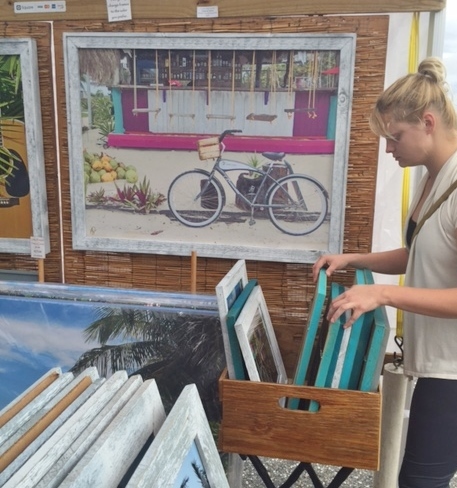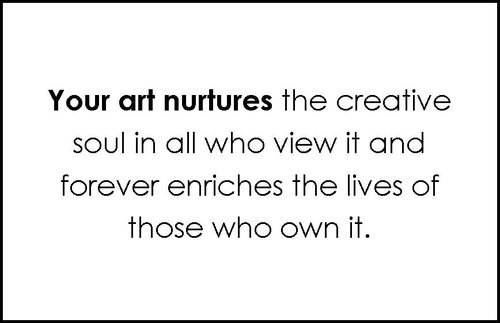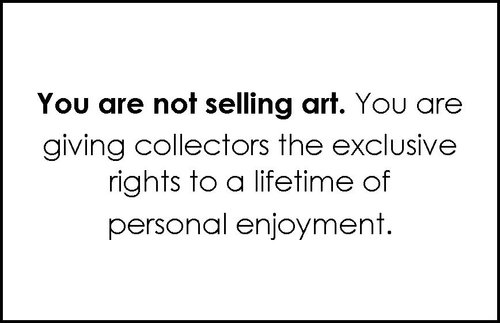by guest blogger Mckenna Hallett
Get ready to change everything you currently believe about selling your art.

First of all: Congratulations! You combed the internet carefully choosing between many dozens of shows. Then you sent in several applications and one of the finest art festivals in the nation accepted you. Now you can list this among your great career accomplishments. Bravo!
You race to add it to your website instantly (don’t miss that step!) and to share it with the world of social media and, of course, your email subscribers. Your acceptance to this highly rated and deeply juried fine arts festival (with its thousands of attendees) tells your collectors and colleagues that you are noteworthy. You have the approval. Again, congratulations!
Now the real work begins.
You embark on the relentlessly winding path of decisions, list making, online researching, and hand wringing. You take a deep breath. This immersion into the “small stuff” can be brutal.
It will require an investment in so much more time, effort, and money than you remember from previous events. That’s because we enter the fog of application acceptance and never really want to question, too deeply, whether it’s worth it. We tell ourselves, “Last season was off. It was just a bad year – a lot of people had poor shows.”
As you jump back and forth in your mind wondering, and worrying about sales, you second-guess everything. You start third and fourth guessing. You wonder about price points: should you have some cheaper items? Do you have enough new work? What will work best in that area/market? Should you take commissions? Or bring the big pieces? Should you have a show special deal, and what might that be?
You do the math and hope to sell at least $xx to cover your expenses. You look back at previous events and know you need to make more sales at this one – or else!
There’s an elephant in the room.
You don’t want to think about it, but you will admit to friends and family, “I really hate the selling part.” Therefore, while you are preparing to sell in a physical sense, you are avoiding the weak link you know is holding you back. You don’t want to deal with the money, actually ask for the sale or be in any way considered a salesperson.
Double-down in your mind to make sure you aren’t appearing to your potential collector as a salesy, sleazy, deal-makin’ salesperson. You move the pendulum to the opposite end. You console yourself with the mantra, “My work sells itself”, or worse, you tell yourself, “If they want it, if it’s meant to be, they will be back.”
By adapting this laissez-faire attitude, you are losing sales, shortchanging your art, and most damaging of all – not getting your art into appreciative homes.

It’s so much easier to bridge that gap when you understand that you are truly loved, admired, and even somewhat idolized by most people who are not artists. In the 9-5 world, your collectors are living vicariously in your artful world. They adore you and love every moment that they gaze at your work in their homes.
You are not selling a mattress or a vacuum cleaner. In fact, you are not “selling” anything.

Selling your art should be like recommending your favorite restaurant.
We all become perfect “salespeople” when we enthusiastically list a myriad of reasons why we think someone should read a book, see a movie, or eat at our favorite restaurant. We all have an instinctive desire to share good things with others. If a rainbow appears in the sky, you would instantly shout to all who can hear, “Look, it’s a rainbow!”
I call this phenomenon the sharing gene. It’s in everyone’s DNA. So sharing your art must become as natural as sharing all that is good and brings good to the recipient of your sharing. It’s virtually a responsibility.
To help you tap into your sharing gene, start with immersing yourself in my Five E’s of Selling:
Empathy – The ability to put yourself in their shoes and actually walk around. It’s always all about them. What do they want? What is important to them?
Enthusiasm – The infectious attitude that draws in their interest and fuels desire. You must also acknowledge and feed their enthusiasm, too.
Encouragement – Your art is a powerful rainbow forming in the distance – one that can last a lifetime! Encouraging ownership is encouraging years of profound “rainbow” moments. Encourage them to share their feelings, too.
Elasticity – Be flexible. Feel the ebb and flow of the engagement, but be ready to snap back into your Selling Purpose. Stretch your imagination and the buyer’s too.
Emergency! – It is always an emergency! If you are not creating a sense of urgency, you are saying this is not important to you. Moreover, you are saying you don’t care about the outcome for them.
I share this list of “E’s” because I love being an artist and making an impact, and I love knowing other artists have made this transition and sold more art.
Furthermore, I love the impact that purchasing art has on the buyer. Read the article What is Affordable Art? and you will be inspired to rethink everything when you do when representing your art to the public. In the end, you need to own three things:
- Your perspective as a creative is valuable to society.
- Your creations are important to everyone who is affected by your art.
- Your collectors are deserving of your devotion to help them find and purchase art from you at your next event.
It seems that we all learn something new every day as small business owners in the age of the internet. Now it is time to learn the most important thing of all: how to sell your art face-to-face to further sustain your career and bring endless joy to collectors.
It’s the polar-opposite of a vicious circle. It’s closing the loop on the love that only an art purchase can perpetuate and inspire.
Mckenna Hallett of MyGoldenWords.com is a frequent guest blogger, motivational speaker, and selling coach.


Interesting article. I found that this was the successful process when I was in art sales. Knowing the creative process and details of the work and, how the artist interpreted the media helped to enhance the collectors interest.
I wonder if your range is limited to Florida, the USA or do you also provide feeds for Canada?
Thanks Lori! Just avoid what I call the “Four Dirty Little Words”: I, Me, My, MIne and replace them with you and yours as much as possible and you have a winning combination!
This was a fabulous article. Thanks for sharing it.
Wow…. Thanks for the big “fabulous” review! Happy to share with my art community!
Awesome article!! I really believe as artists we need to take ‘ownership of our art” and be passionate about what we have created. We need to create a positive energy experience without our booths, and bring that positive energy and excitement to the customers that enter our booth.
Awesome thinking, David. One of the questions I have artists examine is, “How does your art make people FEEL when they see it for the first time?”
If we have that level of empathy before we even make first contact, we are well on our way to a terrific engagement.
Very interesting article! I try to create art that makes people happy when they see it, so even though I haven’t been successful at selling a ton of paintings, I do feel successful as an artist because many people have told me that my art makes them feel happy and smile when they see it. 🙂
Take this idea of happy and expand that Rachel. When artists realize that their art’s impact only grows deeper over time, there is a “responsibility” to #findhomesforart so the collectors joy is never-ending. You owe it to your art and the collector and yourself! Make more art!
Loved every word! Great perspective. I’m an artist and gallery owner, representing 40 artists and you’re right, enthusiasm is key to bringing artist and collector together. thanks for a great article.
As a gallery owner, you have a unique perspective because you might not always “love” the art you have in your gallery. One piece may fall on your “deaf ears”, but be a total symphony to someone walking in and seeing it for the first time.
This is where we need to really understand the principle that it is ALL about THEM. If they love it, you can unconditionally love their appreciation and be the conduit to help them acquire a life time of first impressions.
Enthusiasm for their enthusiasm is still the same ingredient to mix into the engagements and you can’t have that without empathy!
Hello Mckenna,
This is the first article that I have read on this subject that was as close to my point of view that I can recall. I truly agree with all that you have written. The 5 “E’s” work as long as the visitor to your booth is an interested art enthusiast to begin with.
In my short experience (3 years) exhibiting at art shows I have noticed and identified the various types of visitors to the shows and have learned more or less to identify those who are there to experience and perhaps purchase art and those who are there for other reasons such as just tagging along with someone else, walking through on the way to shop or morning stroll, the “I don’t have any money”, ” I don’t have any space”, “we’re downsizing” crowd and my ‘favorite’ ones, those who just want to tell you their life story and end up cornering you and going on nonstop about their artistic aspirations or some other topic.
This I gather, occurs to many artists and everyone has a way of dealing with it.
It is difficult though to apply the methods you outlined to the type of visitors I described. They may show interest in your work and even talk enthusiastically about a certain piece, but when approached about being able to always enjoy it by purchasing and taking it with them, their demeanor changes and the excuses come out. I am always courteous and understanding and never pushy. I dislike the cheap sales tactics employed by those who just know how to push inventory out, regardless of what it is.
My upcoming season is going to be of limited shows (4 at most, depending on acceptance) owing to high costs of the shows and vehicle rentals.
I will endeavor to employ your suggestions and advice to the utmost and be positive. I will make a note to myself to get back to you at the end of the season if you don’t mind, and report on the results.
Thanks,
Bari Tarmon
Bari Tarmon has hit the nail on the head. Being able to deal with the excuses is critical to making a sale (my hubby who is a top sales producer has taught me this). When people say they don’t have the space I let them know that art should be rotated on and off the walls and that when it is put out fresh again or into a different space they will feel the same thrill as when they bought it. The price barrier is difficult because some people can truly not afford my larger pieces so I try and bring some smaller or cheaper pieces (usually studies for larger pieces) and offer them. I do like to make art affordable for everyone. I also find the serious buyers come the first day or evening of the art event. By the third day it is mostly “tire kickers” as my hubby calls them. Having qualifying questions to weed out the buyers from everyone else is also very important. I feel like if we all got together and pooled what works to sell our art we could write a self-help book!
When I saw the opening of your article, I searched for artist’s credit for the booth image. Could not find it. When writing an article, especially about art, you should always give credit for any images that you use, and get permission for its use. I will send this article to my friend, the photographer.
We had permission to take the photo, and to use it in this article. I am the photographer, and also the owner of Artsy Shark.
Not sure why, but my reply to you didn’t get posted. Maybe I got distracted before I hit reply…. Anyway, in the time since you posted, you have been busy Bari! We have had a little private emailing and you even purchased my E’s of Selling Art Guidebook and Flashcards! Woohoo! It’s heading out to you today.
Meanwhile, you had some very important points here and I really want to respond. The “types” of visitors you described are potential buyers with a BIG IF: if you engage them, excite them, examine their needs fully, and encourage them.
Are there people who just want to cruise an art show with no intention of buying? Sure, but as an artist, you know that from time to time, someone has bought from you who had NO intention of buying! Right? They actually said after handing over their credit card, “I had no thoughts about buying art today, but I really love what you are doing and I am so glad to be getting one of your pieces.” Or words to that affect.
Think about WHAT took place that made a total casual observer end up collecting.
Yes, there are plenty of people with plenty of excuses who really will never buy your art. But as you will see in the guidebook, there’s something extra to be gained even from those passerby’s.
And when someone seems to want to just chat endlessly, I have a tip to move away with grace: When another person enters your space, simply say to the chatterer, “I hope you don’t mind, but I need to go greet this person in case they want to purchase my art – unless there was a piece here you are considering purchasing?” They will run away quick as lightning, smiling the whole time and thanking your for your time. They know that you are trying to make a living. You just need to remind them, gently, and they will move along.
Now that you are about to get the guidebook in your hands, please know that I would love to chat after your FIRST show of the season and see if there is any “fine tuning” we can do together!
Love the tactic for getting away from the person who just wants to chat. I often hope if they can’t buy maybe they will spread the word and I will get a sale out of their friend. I love the phrasing too, will try it at my first show this year (Pelham Art Festival, Font Hill, Ontario Canada).
Very good article…I wonder about leaving a chatty person…a polite, but, also a graceful exit that leaves the door open for a future sale?
I really found this helpful, as I was reading it felt like a good friend was giving me excellent advice. Thank you for taking the time to write this.
This is a weird question! What does the artist like about their own work, is it the subject, the brush stroke. I love painting flowers. Sometimes it is amazing how the brush works. Other people don’t always see this.
I find pricing really difficult.
I painted a small painting. A guy came along, asked how much it was. Said he liked it, said it was a good painting but it wasn’t worth the the price I had on it. Do you negotiate. Another person came along, asked would I be there next month.Happy with the price.
The right price for your work is a price that provides you a profit (paying for your overhead and materials, your labor and a margin), and that is competitive in the marketplace. Not everyone will value your work; in fact, most people are not your customer. It’s easy to give an excuse for not buying (wrong price, want to buy later) but those may not necessarily be true, and you shouldn’t try to accommodate those people.
Confidence with your prices is key. Your sales history will determine what you can get for your art, and you can adjust (hopefully upwards) according to demand. I would hesitate to suggest that you negotiate, because it usually isn’t really about price. People buy because they love your work.
I’m happy that I came upon this article as I found it to be quite informative. Even several of the replies offered insight to challenges I face at juried art fairs, when a visitor pops in not to procure a piece, but to make it about themselves asking detailed questions about my photographic gear, my opinions on gear, my approach, post processing, techniques and the list goes on and on! I had a neighboring artist witness this once, and shortly after I successfully ended the conversation, came over to me a smile and said “I see you picked up a parasite before”. I thought it was a comical analogy to something that is distracting me from my collectors. Once again, I gained from this!!
Thanks for your comment, Thom. It isn’t unusual to run into those “parasites” but it is good to keep conversation going and stay positive!